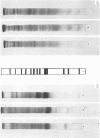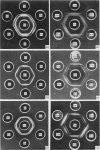Abstract
Membrane and soluble fractions of one genital and two oral strains of Mycoplasma hominis were compared by immunodiffusion and polyacrylamide gel electrophoresis. Differences were demonstrated between the membrane antigens of the three strains by immunodiffusion, and the membrane proteins also gave dissimilar patterns in polyacrylamide gel electrophoresis. The soluble fractions gave identical lines in immunodiffusion tests and similar patterns in polyacrylamide gel electrophoresis.
When the strains were cross-titrated in metabolic inhibition (MI) and indirect haemagglutination (IHA) tests, statistical analysis of the results revealed significant differences between the strains. Previously, growth-inhibition, MI and IHA activity was shown to be associated with the membrane antigens of M. hominis, so the intraspecies differences revealed by MI and IHA correlate with the differences in the membrane antigens demonstrated by immunodiffusion. Growth-inhibition tests, which might also have been expected to show intraspecies differences, did not do so, probably because of the insensitivity of the test. In contrast to MI and IHA, complement-fixation (CF) tests revealed a high degree of relatedness between the strains. This is consistent with the observation that the soluble antigens of M. hominis participate in the CF reaction, and that the soluble antigens of different strains are identical in immunodiffusion tests.
Full text
PDF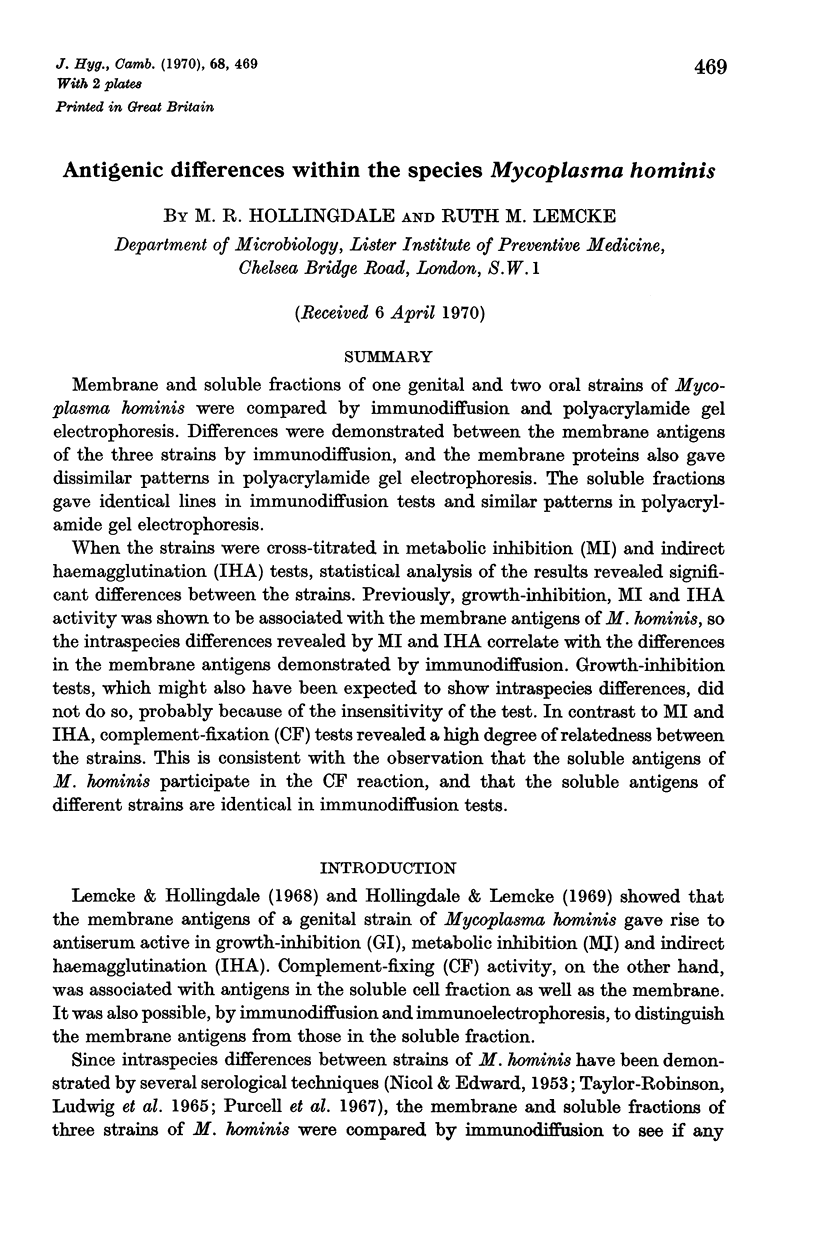
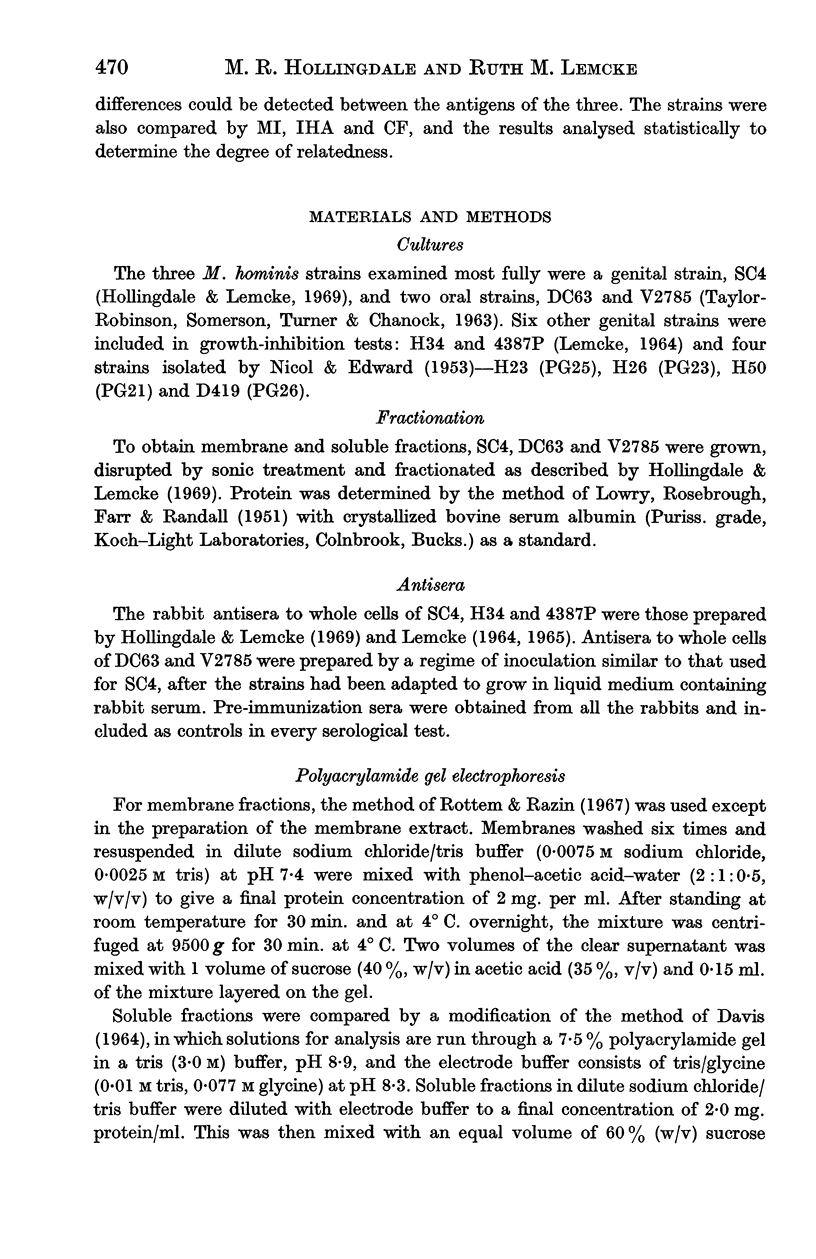
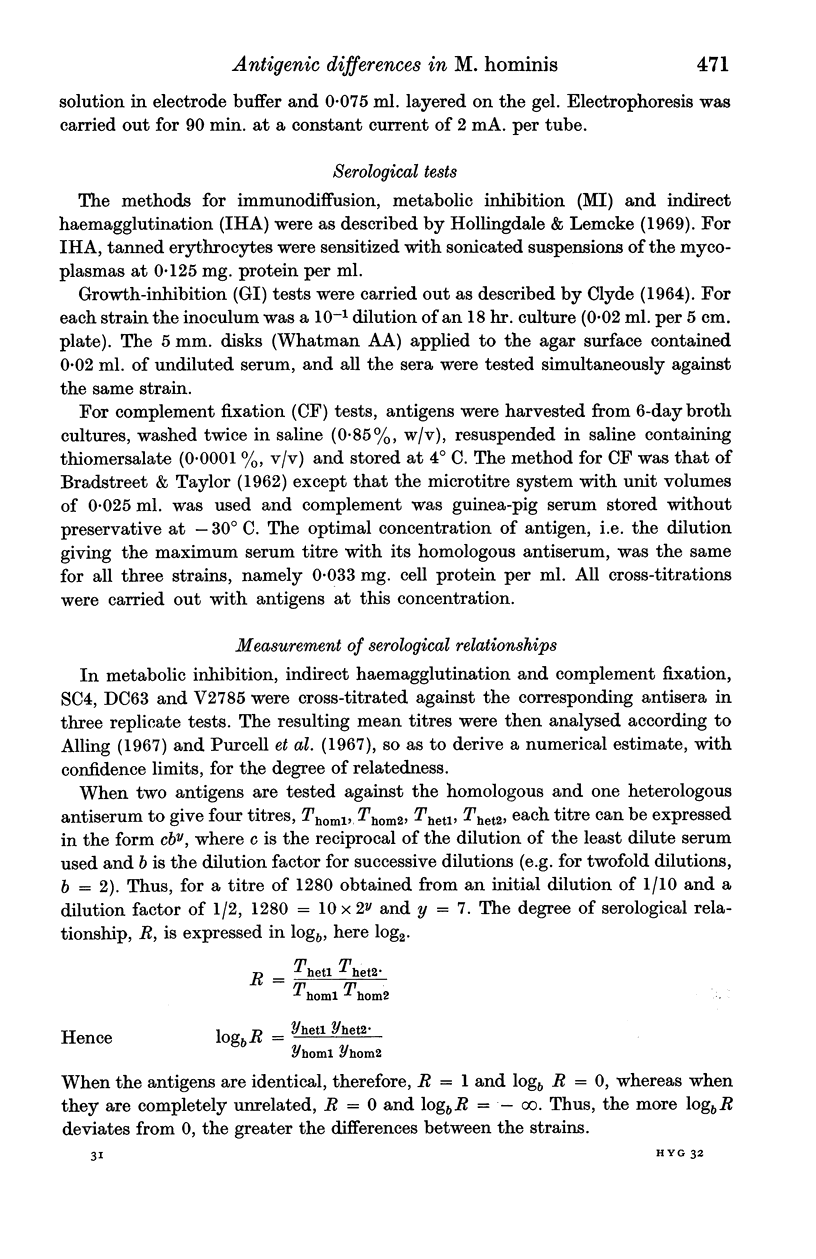
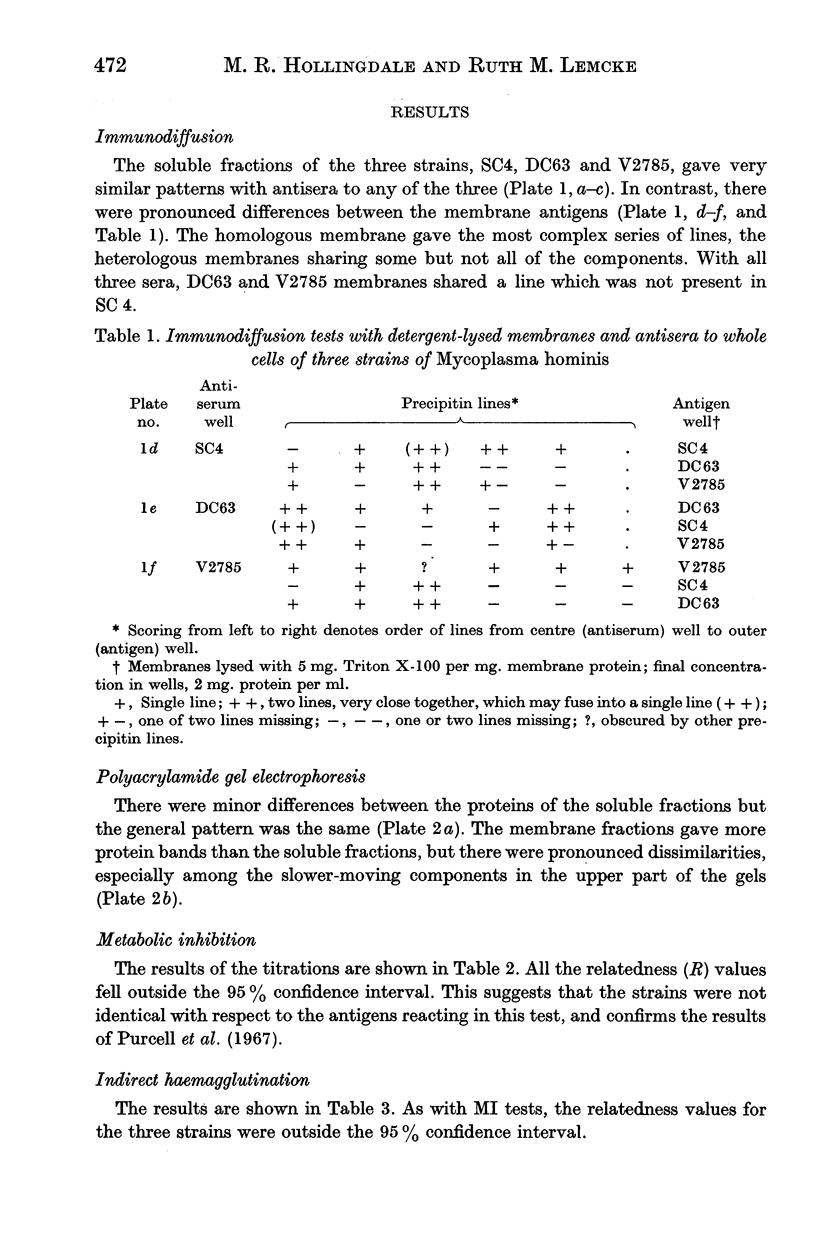
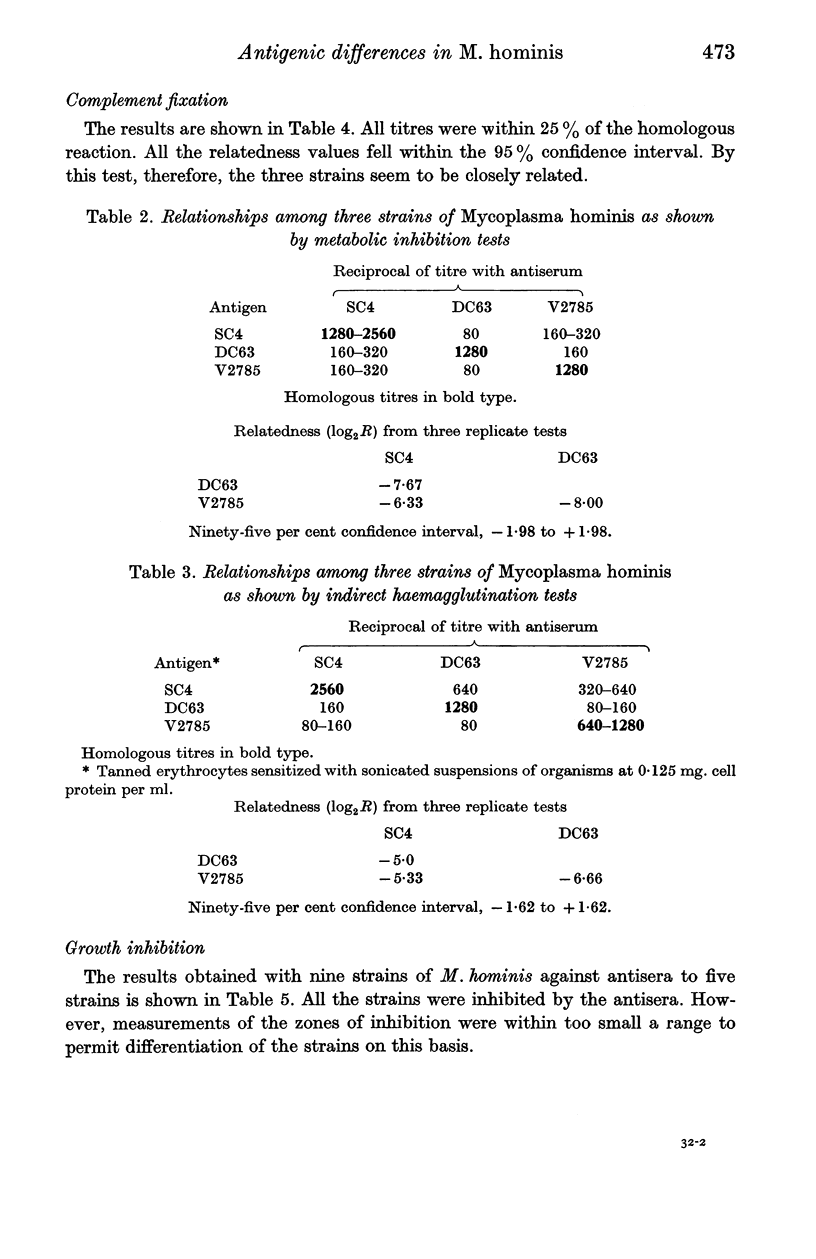
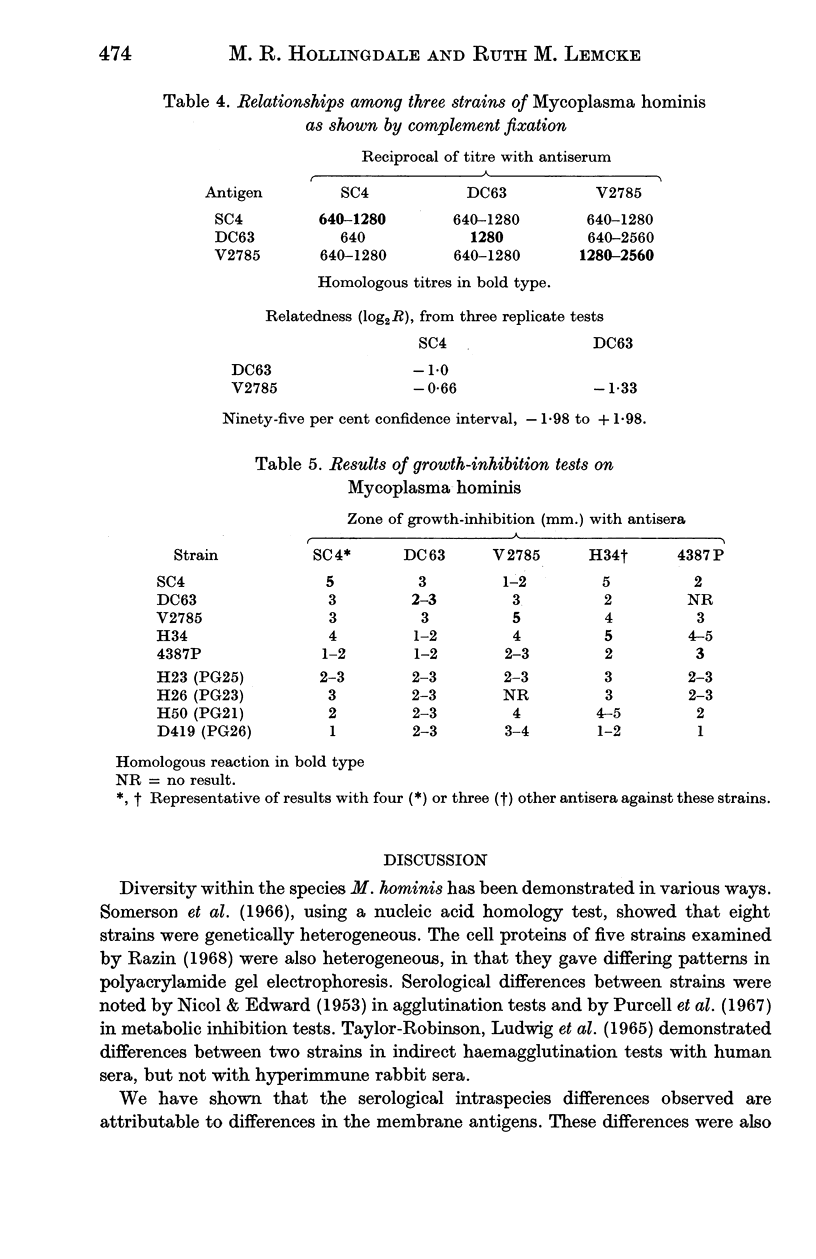
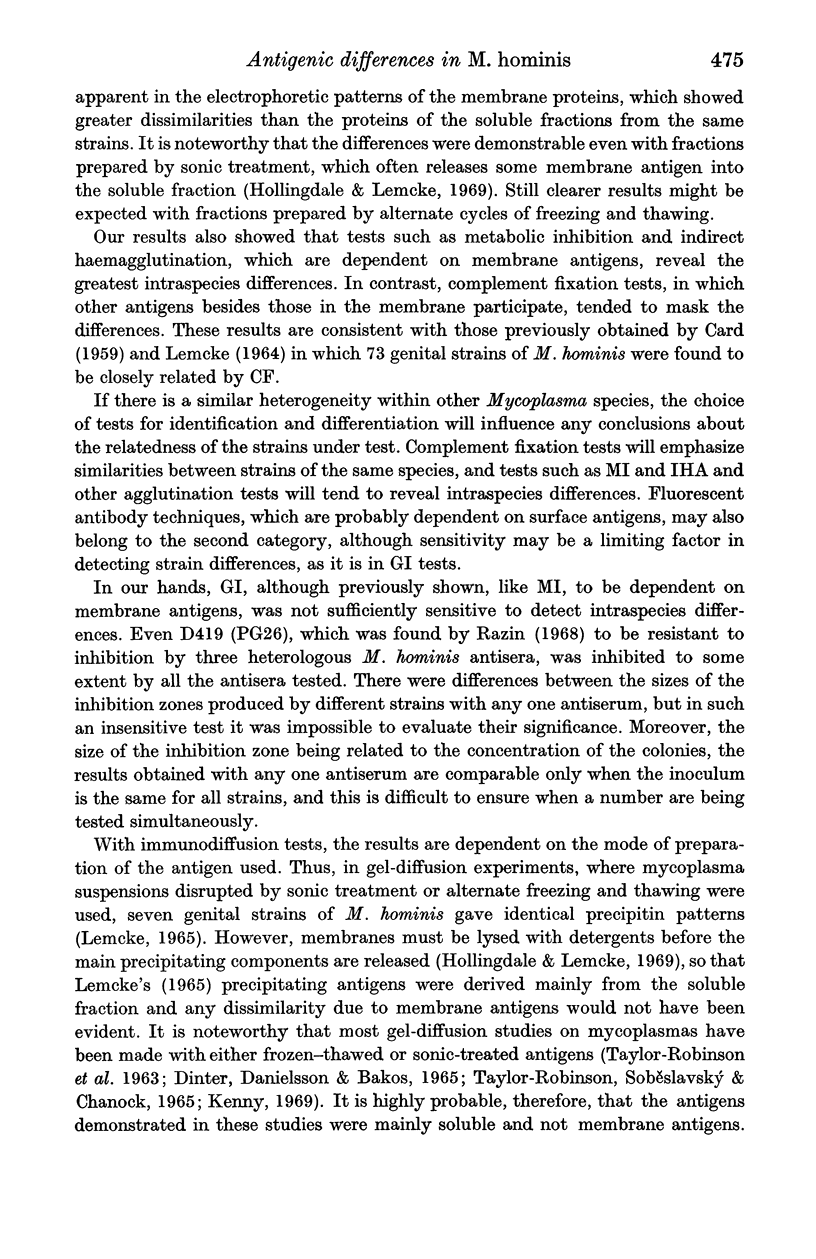
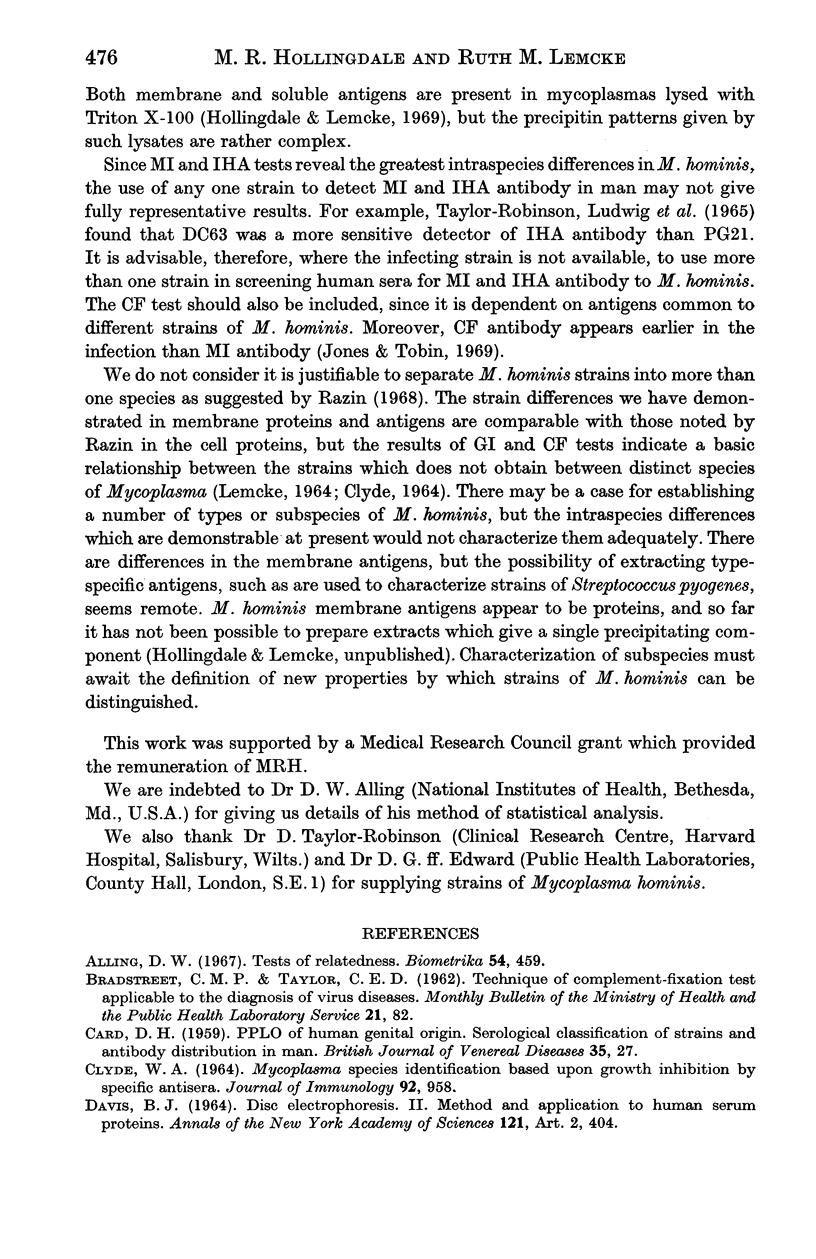
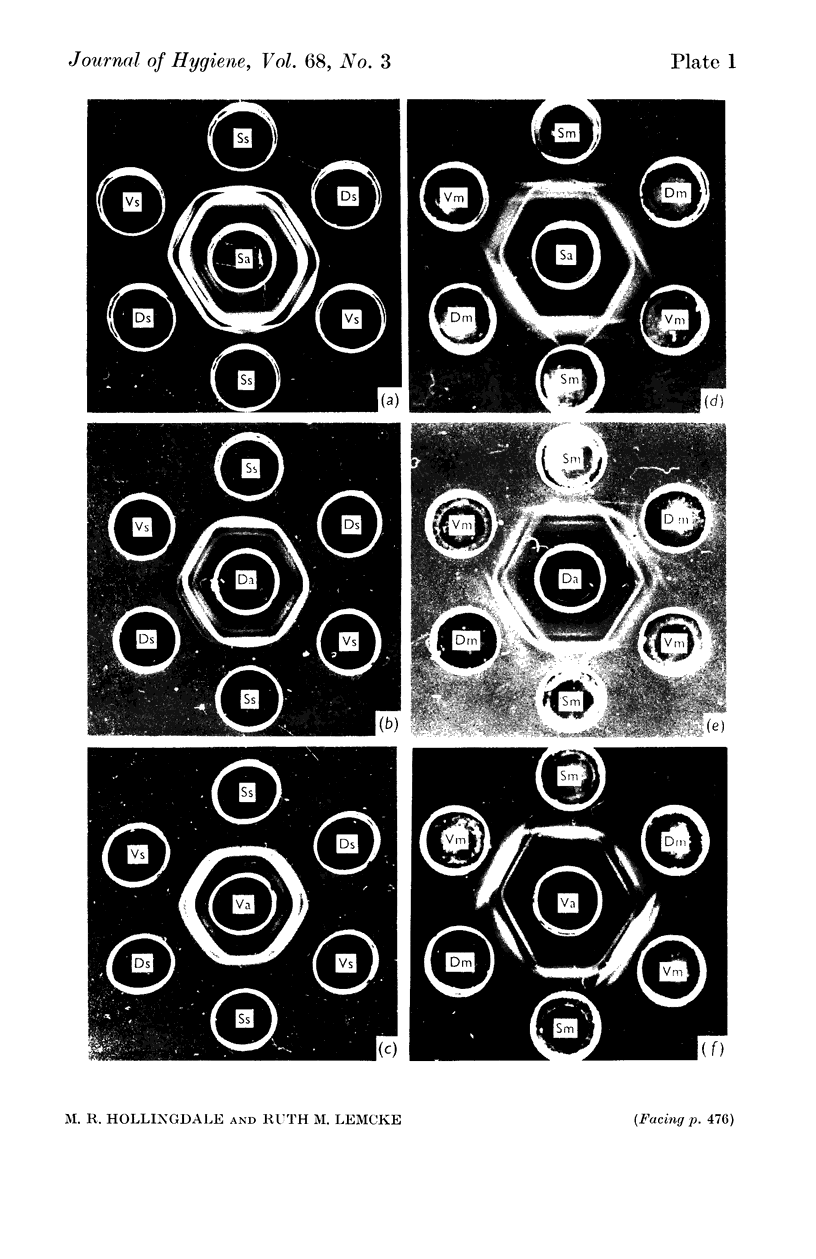
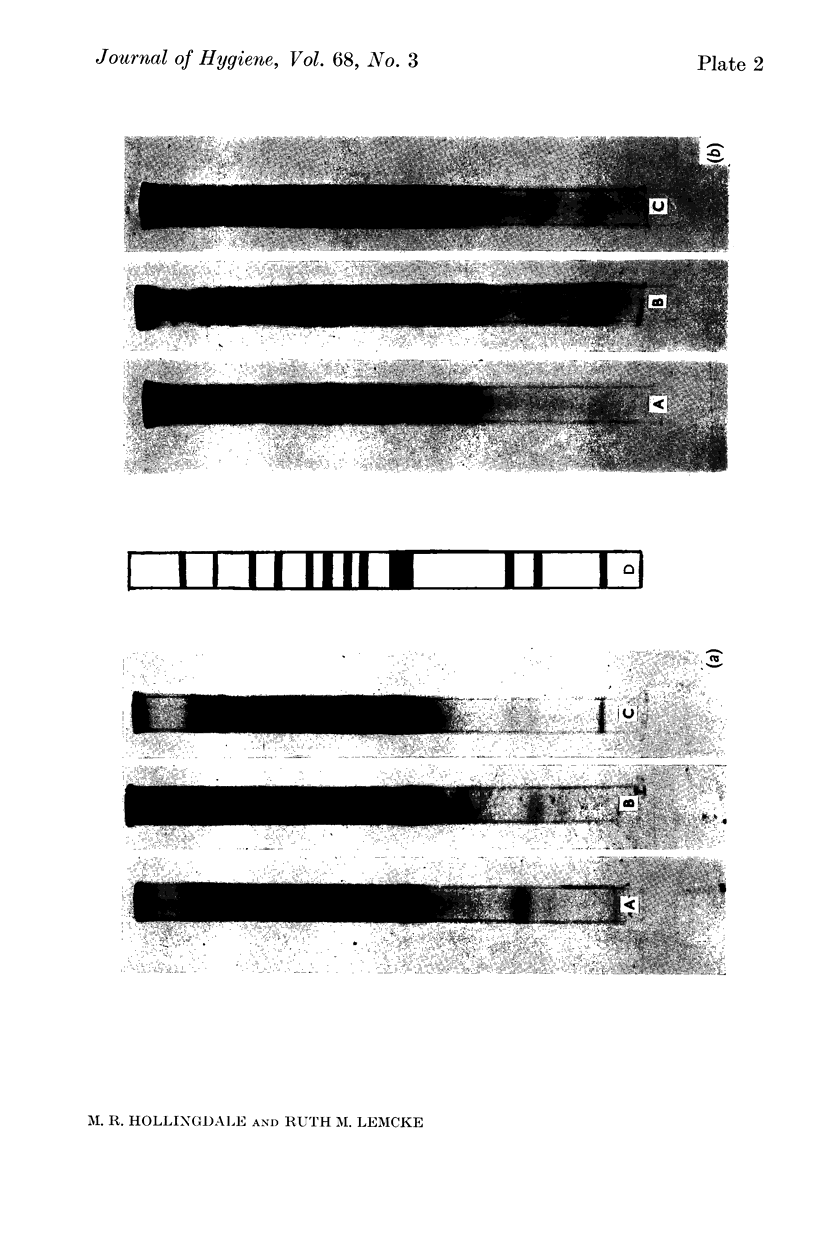
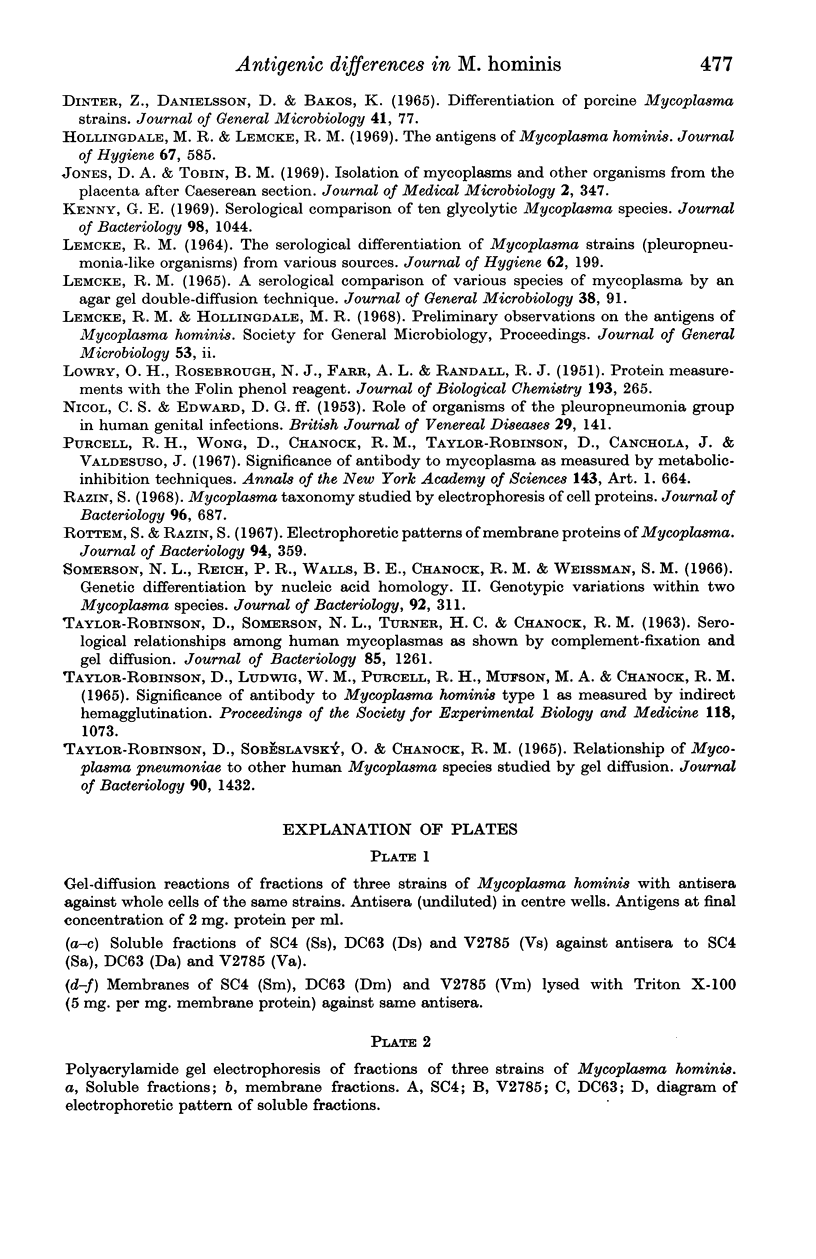
Images in this article
Selected References
These references are in PubMed. This may not be the complete list of references from this article.
- Alling D. W. Tests of relatedness. Biometrika. 1967 Dec;54(3):459–469. [PubMed] [Google Scholar]
- CARD D. H. PPLO of human genital origin; serological classification of strains and antibody distribution in man. Br J Vener Dis. 1959 Mar;35(1):27–34. doi: 10.1136/sti.35.1.27. [DOI] [PMC free article] [PubMed] [Google Scholar]
- CLYDE W. A., Jr MYCOPLASMA SPECIES IDENTIFICATION BASED UPON GROWTH INHIBITION BY SPECIFIC ANTISERA. J Immunol. 1964 Jun;92:958–965. [PubMed] [Google Scholar]
- DAVIS B. J. DISC ELECTROPHORESIS. II. METHOD AND APPLICATION TO HUMAN SERUM PROTEINS. Ann N Y Acad Sci. 1964 Dec 28;121:404–427. doi: 10.1111/j.1749-6632.1964.tb14213.x. [DOI] [PubMed] [Google Scholar]
- Dinter Z., Danielsson D., Bakos K. Differentiation of porcine Mycoplasma strains. J Gen Microbiol. 1965 Oct;41(1):77–84. doi: 10.1099/00221287-41-1-77. [DOI] [PubMed] [Google Scholar]
- Hollingdale M. R., Lemcke R. M. The antigens of Mycoplasma hominis. J Hyg (Lond) 1969 Dec;67(4):585–602. doi: 10.1017/s0022172400042042. [DOI] [PMC free article] [PubMed] [Google Scholar]
- Jones D. M., Tobin B. M. Isolation of mycoplasms and other organisms from the placenta after caesarean section. J Med Microbiol. 1969 Aug;2(3):347–352. doi: 10.1099/00222615-2-3-347. [DOI] [PubMed] [Google Scholar]
- Kenny G. E. Serological comparison of ten glycolytic Mycoplasma species. J Bacteriol. 1969 Jun;98(3):1044–1055. doi: 10.1128/jb.98.3.1044-1055.1969. [DOI] [PMC free article] [PubMed] [Google Scholar]
- LEMCKE R. M. A SEROLOGICAL COMPARISON OF VARIOUS SPECIES OF MYCOPLASMA BY AN AGAR GEL DOUBLE-DIFFUSION TECHNIQUE. J Gen Microbiol. 1965 Jan;38:91–100. doi: 10.1099/00221287-38-1-91. [DOI] [PubMed] [Google Scholar]
- LEMCKE R. M. THE SEROLOGICAL DIFFERENTIATION OF MYCOPLASMA STRAINS (PLEURO-PNEUMONIA-LIKE ORGANISMS) FROM VARIOUS SOURCES. J Hyg (Lond) 1964 Jun;62:199–219. doi: 10.1017/s0022172400039930. [DOI] [PMC free article] [PubMed] [Google Scholar]
- LOWRY O. H., ROSEBROUGH N. J., FARR A. L., RANDALL R. J. Protein measurement with the Folin phenol reagent. J Biol Chem. 1951 Nov;193(1):265–275. [PubMed] [Google Scholar]
- Lemcke R. M., Hollingdale M. R. Preliminary observations on the antigens of Mycoplasma hominis. J Gen Microbiol. 1968 Aug;53(1 Suppl):ii–ii. [PubMed] [Google Scholar]
- NICOL C. S., EDWARD D. G. Role of organisms of the pleuropneumonia group in human genital infections. Br J Vener Dis. 1953 Sep;29(3):141–150. doi: 10.1136/sti.29.3.141. [DOI] [PMC free article] [PubMed] [Google Scholar]
- Purcell R. H., Wong D., Chanock R. M., Taylor-Robinson D., Canchola J., Valdesuso J. Significance of antibody to mycoplasma as measured by metabolic-inhibition techniques. Ann N Y Acad Sci. 1967 Jul 28;143(1):664–675. doi: 10.1111/j.1749-6632.1967.tb27712.x. [DOI] [PubMed] [Google Scholar]
- Razin S. Mycoplasma taxonomy studiedy electrophoresis of cell proteins. J Bacteriol. 1968 Sep;96(3):687–694. doi: 10.1128/jb.96.3.687-694.1968. [DOI] [PMC free article] [PubMed] [Google Scholar]
- Rottem S., Razin S. Electrophoretic patterns of membrane proteins of Mycoplasma. J Bacteriol. 1967 Aug;94(2):359–364. doi: 10.1128/jb.94.2.359-364.1967. [DOI] [PMC free article] [PubMed] [Google Scholar]
- Somerson N. L., Reich P. R., Walls B. E., Chanock R. M., Weissman S. M. Genetic Differentiation by Nucleic Acid Homology II. Genotypic Variations Within Two Mycoplasma Species. J Bacteriol. 1966 Aug;92(2):311–317. doi: 10.1128/jb.92.2.311-317.1966. [DOI] [PMC free article] [PubMed] [Google Scholar]
- TAYLOR-ROBINSON D., LUDWIG W. M., PURCELL R. H., MUFSON M. A., CHANOCK R. M. SIGNIFICANCE OF ANTIBODY TO MYCOPLASMA HOMINIS TYPE 1 AS MEASURED BY INDIRECT HEMAGGLUTINATION. Proc Soc Exp Biol Med. 1965 Apr;118:1073–1083. doi: 10.3181/00379727-118-30049. [DOI] [PubMed] [Google Scholar]
- TAYLOR-ROBINSON D., SOMERSON N. L., TURNER H. C., CHANOCK R. M. SEROLOGICAL RELATIONSHIPS AMONG HUMAN MYCOPLASMAS AS SHOWN BY COMPLEMENT-FIXATION AND GEL DIFFUSION. J Bacteriol. 1963 Jun;85:1261–1273. doi: 10.1128/jb.85.6.1261-1273.1963. [DOI] [PMC free article] [PubMed] [Google Scholar]
- Taylor-Robinson D., Sobeslavský O., Chanock R. M. Relationship of Mycoplasma pneumoniae to other human Mycoplasma species studied by gel diffusion. J Bacteriol. 1965 Nov;90(5):1432–1437. doi: 10.1128/jb.90.5.1432-1437.1965. [DOI] [PMC free article] [PubMed] [Google Scholar]
- WAKEFIELD J. The organization of public education about cancer. Mon Bull Minist Health Public Health Lab Serv. 1962 May;21:82–88. [PubMed] [Google Scholar]



